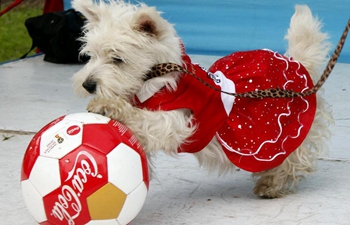WASHINGTON, June 11 (Xinhua) -- American researchers have developed a hydrogel that can release a nerve-protecting agent at the site of spinal cord injury, restoring independent breathing in rat models.
A study published on Monday in the Journal for Neuroscience described the gel binding to the neuro-stimulating agent BDNF (brain-derived neurotrophic factor), a nerve-growth factor that has been explored in clinical trials for amyotrophic lateral sclerosis (ALS) patients.
One of the most severe outcomes of spinal cord injury from car accidents, sports impacts, or other neck trauma, is losing the ability to control breathing, with patients often requiring artificial ventilation for the rest of their lives.
"The hydrogel can deliver a neuron-stimulating agent that repairs a critical aspect of spinal cord damage, while avoiding systemic side effects of the agent," said the paper's co-senior researcher Angelo Lepore, associate professor of neuroscience at Philadelphia University plus Thomas Jefferson University.
When BDNF circulates systemically through the blood and entire nervous system, it can cause side effects such as muscle spasms and chronic pain.
"The gel has the property of being able to release a specific dose, over a controlled period of time, in a particular area, can be implanted in a safe manner, and is biocompatible so the body does not mount an immune response to it," said the paper's co-first author Biswarup Ghosh, a research associate at Lepore's laboratory.
The researchers focused specifically at the bundle called the phrenic nerve that specifically controls the diaphragm, the muscle that primarily controls the rhythmic inflation of the lungs.
The researchers saw a 60 percent to 70 percent improvement in breathing control as measured by diaphragm-muscle contraction in rats that received the BDNF gel after spinal cord injury.
At the cellular level, there're at least two ways the BDNF-gel protected or helped maintain the brain-to-spine-to-diaphragm connection, according to the study.
The long phrenic nerves, with one end of the cell sitting at the spinal cord and the other end touching the diaphragm muscle, may release their connection to the muscle when the other end of the nerve was damaged at the spinal column.
Lepore's team showed that the gel helped nerves reconnect, or protected these nerves from releasing in response to the damage.
Another set of nerves travels from the brain to the spinal column to help set and maintain the rhythmic control of inhalation. Those nerves can also be damaged during injury.
The researchers showed that the BDNF gel helped regrow the nerves that connected the rhythm-control center of the brain with the spine and ultimately the diaphragm muscle.
"Although there are yet other types of damage that can occur during spinal cord injury, it's encouraging to see this gel improve two extremely-important mechanisms by which breathing control is lost," said Lepore.
The researchers plan to continue the work by exploring the ideal timing and dosing for applying the biogel and they would assess whether it could work in instances where treatment isn't immediately available after injury.
















